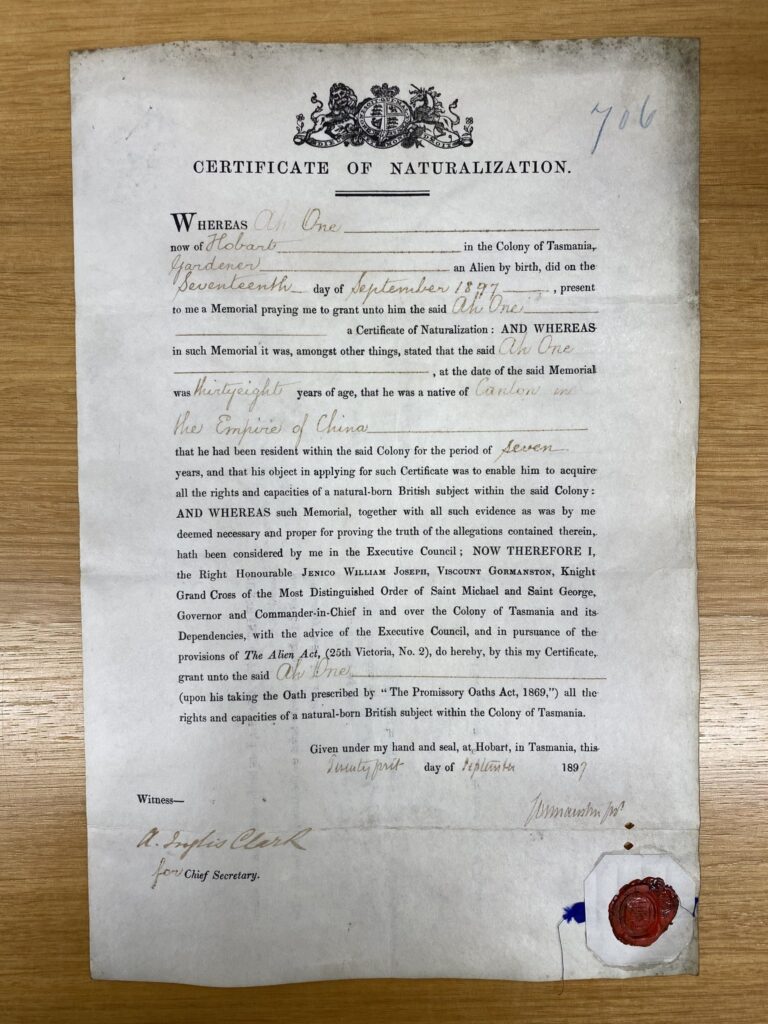While visiting Canberra in January 2021, I looked (again) at a collection of Tasmanian naturalization certificates held in the National Archives of Australia in series A804. Here’s one of the stories found in these records – which I tweeted at the time but have reproduced here for posterity.
Let’s have a look at one of the Tasmanian naturalization certificates from NAA: A804 to see what we can find out. This one caught my eye because it was witnessed by Andrew Inglis-Clark, and it has no annotations related to travel (NAA: A804, 706).
The certificate was issued to Ah One, a gardener from Hobart, on 21 September 1897. He was 38 years old, a native of Canton in the Empire of China, and had lived in Tasmania for seven years. He had applied for naturalization on 17 September 1897.
On the back of the certificate we can see that Ah One swore the required oath on 24 September 1897, before a Commissioner of the Supreme Court of Tasmania, and this was ‘enrolled and recorded’ the same day by the Supreme Court Registrar (No. 706, Bk 5, page 247).
Tasmanian Archives holds colonial naturalization records for Tasmania, so more information about Ah One’s application can be found there – using both the Tasmanian Names Index and the information provided on the certificate.
A search of the Tasmanian Names Index led to Ah One’s naturalization application (memorial) and correspondence about it (CSD22/1/3/56 pp 216–218, https://stors.tas.gov.au/CSD22-1-3-56$init=CSD22-1-3-56-P216).
The memorial gives more information about Ah One: he was born at Canton on 1 February 1859; he arrived at Hobart on the Southern Cross in 1890; he could sign his name in English; and his application was endorsed by JG Davies, JP and Mayor of Hobart.
The accompanying correspondence shows that Ah One was one of nine Hobart gardeners who applied for naturalization at the same time through Tinning & Propsting Solicitors, all endorsed by the Mayor of Hobart.
The nine gardeners were: Ah Doo, Ah Look, Ah Now, Ah One, Ah Koon, Hie Mane, Kie Sung, Sing Gin, and Sing None.
The approval process took four days and issuing their naturalization certificates cost the applicants 2s 6d each.
On the back of Ah One’s naturalization certificate in NAA: A804 is the annotation ‘No. 706, Bk 5, page 247’ – which refers to Tasmanian Supreme Court series SC415, which contains copies of denization and naturalization certificates. A copy of Ah One’s certificate is found on pp. 247–8 of Book 5 (SC415/1/5, https://stors.tas.gov.au/SC415-1-5-P247).
Under s 7 of the Aliens Act 1861 (Tas), a copy of each naturalization certificate had to ‘be enrolled for safe custody as of record in the Supreme Court’.
Almost 600 Chinese people were naturalised in Tasmania up to December 1903. Tasmania stopped naturalizing Chinese people after the new Commonwealth Naturalization Act 1903 came into force from 1 January 1904. By contrast, New South Wales and Victoria stopped naturalizing Chinese in the mid-1880s.








Last year I watched a NLA webinar on Chinese family history. I was hoping to get to Canberra to visit NLA but haven’t been able to get away as yet. It’s on my plan for this year. Although I have a copy of my 2nd great grandfather’s naturalisation forms, there were no Chinese characters on the copy which I have. Hopefully there will be other records there which may give me some leads. He was from ‘near Amoy’ and is suspected that he was an indentured labourer. The first official record of him is his marriage to my 2nd great grandmother in 1863 at Avondale (now Dapto).
Kate, thank you for your continuing research and publications. Just a small question regarding the above person described as Ah One – would I be correct in thinking his surname is Ah and his given name is One? My ancestor was James Ah Chip(p) and I had always thought that Ah Chipp was his surname?
Kind regards
Sue
Hi Sue
‘Ah’ or ‘A’ can be found many of the Chinese personal names we come across when researching Chinese Australian history. It represents the character 阿 (or 亞), which is a prefix added to a given name as a familiar or informal form of address, much like adding ‘ie’ or ‘y’ to the end of a name in English, e.g. Ann / Annie, Thomas / Tom / Tommy).
So, with Ah One’s name, ‘One’ would probably have been his given name, or part of it. With your ancestor James Ah Chipp, ‘Chipp’ would similarly have been part of his Chinese given name, which may have comprised one or two characters.
You might be interested to read these other blog posts of mine that delve into the question of names:
Kate
Thanks you for your reply Kate, every learning step is welcome. Kind regards, Sue